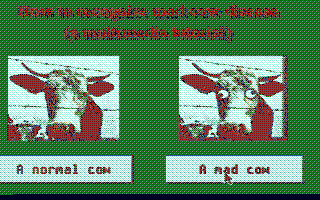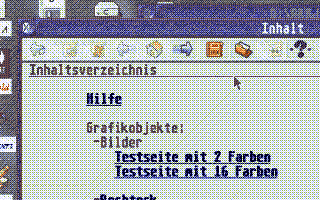HOW
GREEN IS MY GEM.
People are still writing utilities...
And they are, little things, maybe even some big things out there, but I'll
get onto those in another article (HighWire!)Right now, we turn our
attention to some of the smaller things in life, starting with something
that can't really be categorised easily, or explained..
'Mad Cow v2.3'
This is a stab into something we might call 'weird-ware'? Gregory Pawlik,
the maker of Marijuana Mail took a few minutes out to put together a little
joke in a Gem window. Or maybe it is a useful guide to spotting some of the
perils of the countryside? The screenshot below illustrates what it does.
Click on the left hand button to hear the familiar sounds coming from a
normal cow. On the right, you can hear what strange noises will come from a
mad cow.

Mooo! I'm Maaad! I'm really MAD!
'Mad Cow' is good for a momentary conversation piece, then a longer moment
of embarrassed silence afterwards, whilst the friend you were proudly
showing it wonders what the hell you were on about?
'Hyp-View' (v0.14)
On the other hand, this little proggy falls into the category of being
potentially something a lot more useful. Philip Donze took it on himself to
write a modern replacement for the popular but currently unsupported 'ST-
Guide' hypertext file reader. There is still a role for this HTML-style
language, the instructions for Aniplayer, the very active multimedia
application, come as .HYP format, for example.
Hyp-View considerately takes in updated gem desktops. No more dour and grey
monochrome for them. The screenshot reveals a very pretty control panel
within the gem window. Next thing, it can display more colours in the text
than ST monochrome. At least up to sixteen colours according to the test
document, and I shouldn't be surprised if even more in the way of enhanced
colour support is on the cards for future versions.

Look at the pretty icons!
It is nicely compliant with things like multitasking O/S's (of course). It
does a good job right now, even with this very early version number, and no
doubt, Philip has got more planned for this. The instructions and history
file are in Deutsch, but it is easy enough to work out what it does without
any reference to them.
Overall, a nice new take on a popular but elderly application.
'Cresus' (Croesus) Money Manager
Pierre Tonthat, previously best known for a strange little Shakespearian
BubbleGEM utilising insult generator, has been working away quietly, almost
unnoticed, on what looks like quite a smart modern GEM-based and GFA coded
money manager program.
The basics of what it does can be quite happily covered by a determined
person with a set of bank statements, a carefully sharpened pencil, and a
cheap pocket calculator. That is, if the business of keeping track of your
deteriorating finances doesn't throw you into a black fugue of depression.
Where the clever stuff comes into hand though, is with what goes over and
above that.
So you can use Cresus to keep track of several password-protected account
records, each in different names and each with different banks. You also
have the choice of several different currencies, including several made
defunct at the beginning of this year when the Euro was introduced. Is this
an elderly beta version, or does Pierre know something about the inner
workings of EU financial policy and the future of the Euro project, that we
don't? There are other functions that I can't get into yet. For example,
there seems to be the basis of a currency converter, this being the sort of
thing that computers are really good at, but I can't get it to do anything.
This may be down to the fact that I'm running an incomplete beta version.
Also, there isn't a lot in the way of documentation, so you have to fumble
your way around.
Certainly there are more features promised, many of them to do with using
modern GEM features, such as online documentation, and BubbleGEM support. As
it is, Cresus makes good use of a modern multi-tasking desktop, with icon-
able windows, and the ability to use aesthetically pleasing non crummy NVDI
fonts.
This will become shareware, when it is more or less complete at version
1.00. Then you can decide if you want to shell out to precisely and
depressingly keep a close eye on where your money goes...
'Porthos' PDF Document Displayer. (v2.05 Unregistered)
If you spend any amount of time around a Wintel PeeCee, a depressing act
which the majority of us are forced to undergo, then you may well be
familiar with the portable document format known as *.PDF.
It's a bit like HTML, or more familiarly for Atari users, the Hypertext
document. Unlike Hypertext though, .PDF displayers for Atari have been
rather thin on the ground, or obscure, until now.
There is an early attempt at getting .PDF to run on the upcoming Highwire
browser. This is at a very early stage, and my machine seems to ignore it
completely. However, for a more advanced product, Wolfgang Domrose, under
the 'Software Invers' label, steps in with his production, "Porthos".
Porthos displays a .PDF document, allowing you to view it onscreen, and
print it out. It also allows exporting of the individual textual and
graphical components of the document, as Calamus vector files, and .TIF
images for any graphics. There are a series of navigation and manipulation
controls at the head of the page, in a format similar to a web browser. So
you get document and page navigation, and find in text features, and also
various options for printing the document.
It is usefully multilingual, with a choice of eight languages, including
Polski! These can be selected almost 'on the fly'. Porthos also supports
BubbleGem, if you happen to have that installed. It also seems happiest on a
multi-tasking machine. I've not tried it on single-TOS yet, but I get the
impression that it would prefer not to!
My .PDF experience for this review was very limited, being confined to the
single page and text only example document that came with the Highwire
package. One immediate impression was that this was not the quickest show on
earth, taking a good few seconds to format and display this fairly simple
document. So Porthos could be called from within a browser such as CAB as a
third party displayer, but you might be better off waiting for the CT60, or
running it under Aranym to do so. I would stress that it is unknown to me
how cumbersome the .PDF format is on something sub-Pentium in any case? I
might add that I was also using my GEM-default 50 mhz CT2 option for this
review.
Delving in a little bit further seems to show that it is possible to make
changes to the layout of your pre-loaded .PDF document, and then save the
changes, but I resisted the temptation.
Once displayed, Porthos seems to do the job nicely, using any NVDi fonts
that you've got to best effect, The general impression is one of a lot of
work put in, and something at the level of high quality shareware. Which is
what Porthos ultimately is. Apart from a single readme file, there is very
little English documentation, although fans of Deutsch will have great
enjoyment.
If you wish to spend more time with the .PDF format on your higher end
Atari, it might be useful to contact the author on his email address:
porthos.domroese@harz.de
Okay, that's it for this issue!
CiH, for Alive! Mag,Oct/Nov '02
|



